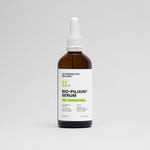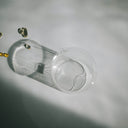The widow’s peak hairline has sparked curiosity, admiration, and even a few wild superstitions over the years.
Some say it’s a sign of mysterious charm, while others link it to ominous predictions. But what’s the truth behind the widow peak hairline superstition?
Let’s separate fact from fiction and dive into the fascinating history and myths surrounding this distinctive feature.
Table of content
What is a widow’s peak?
A widow’s peak is a hairline that forms a V-shaped point in the center of the forehead. While it’s a unique genetic trait, it doesn’t have any hidden meanings or special significance beyond its appearance.
This distinct hairline varies from person to person. For some, it’s a sharp, dramatic point, while others have a subtle dip that’s barely noticeable.
Genetically, the widow’s peak is thought to be influenced by dominant traits, but researchers believe multiple genes might be at play.
It’s simply one of those quirks that make you uniquely you, like freckles or dimples.
Whether you love your widow’s peak or don’t think twice about it, it’s important to know it’s just a natural feature.
And, no, it doesn’t say anything about your destiny or personality—despite what old wives' tales might suggest.
As your leading source for hair health information over the past 4 years, we never compromise on accuracy. When it comes to your health, you deserve information you can truly rely on - and earning your trust is our top priority.
Here's how Scandinavian Biolabs ensures every piece of content meets the highest standards of accuracy and integrity:
- Credentialed Experts: Our reviewers are actively practicing doctors and medical researchers
- Stringent Reviews: Content undergoes rigorous editing by subject specialists and review by a practicing doctor.
- Evidence-Based: We rely on well-established research from trusted scientific sources like peer-reviewed journals and health authorities.
- Full Transparency: Our editorial standards, writer credentials, reviewer credentials, correction process, and funding are all publicly documented.
- Independent Voice: While we do promote products, we operate in a vacuum to business operations. Our main goal is just an unwavering commitment to providing medically-sound guidance.
You can count on Scandinavian Biolabs to consistently deliver the trustworthy health information you deserve. Read our Editorial Standards.
The origins of widow’s peak superstitions

The term “widow’s peak” dates back centuries, with its roots in European mourning traditions. In the 18th century, widows often wore hoods or caps with a pointed front that dipped down in the middle of the forehead.
This somber piece of attire symbolized their loss and inspired the name we use today.
Over time, folklore began associating the widow’s peak hairline with early widowhood. The idea was that those with this V-shaped hairline might bring bad luck to their spouses or experience heartbreak themselves.
There’s no evidence to back this up, of course, but the superstition managed to stick around.
Pop culture hasn’t exactly helped. Villainous characters like Dracula and the Joker often sport widow’s peaks, adding to their mystique and reinforcing the connection between this hairline and something ominous.
Yet, many beloved celebrities like Marilyn Monroe and Keanu Reeves also have widow’s peaks, proving this feature is just as likely to symbolize charm and charisma.
As society moved away from strict mourning traditions, the superstition began to fade. Today, most people see the widow’s peak for what it is—a unique and striking genetic trait.
Common myths and beliefs about widow’s peaks
The widow’s peak has attracted its fair share of myths. Let’s explore some of the most common ones, debunk them, and get to the truth.
Myth 1: A widow’s peak predicts early widowhood
This myth suggests that having a widow’s peak is an omen of losing your spouse early in life. Sounds spooky, right? Fortunately, there’s zero evidence to support this idea.
It’s nothing more than a leftover superstition from a time when mourning traditions were deeply ingrained in daily life.
Think about it: If widow’s peaks were truly tied to widowhood, wouldn’t there be scientific studies proving it by now? Rest easy—your hairline has no say in your marital future.
Myth 2: A widow’s peak indicates a sinister personality
Thanks to Hollywood, widow’s peaks often get paired with villains. Dracula? Widow’s peak. The Joker? Widow’s peak.
This trope has made people associate the feature with a darker, more mysterious personality.
In reality, there’s nothing sinister about this hairline. Plenty of “good guy” celebrities, like Keanu Reeves and Vanessa Williams, sport widow’s peaks and radiate positivity.
It’s just another example of how media shapes our perceptions without a shred of truth.
Myth 3: A widow’s peak means higher intelligence or creativity
On a more flattering note, some believe widow’s peaks are linked to heightened intelligence or artistic talent. While it’s nice to think your hairline might come with a bonus superpower, there’s no scientific basis for this claim.
Intelligence and creativity are complex traits influenced by a combination of genetics, upbringing, and environment—not by the shape of your hairline.
Widow’s peaks are cool, but they’re not a magic ticket to genius status.
Debunking the superstitions
When it comes to widow’s peaks, myths and misconceptions abound. Let’s tackle some of the most common ones head-on and set the record straight.
Myth 1: A widow’s peak predicts early widowhood
This age-old superstition claims that having a widow’s peak means losing your spouse early in life. It’s rooted in 18th-century mourning traditions, where widows wore pointed hoods that vaguely resembled the hairline.
But let’s be real: no hairline shape has the power to predict the future.
Science doesn’t support this claim, and it’s time to leave this outdated belief where it belongs—in the history books.
Myth 2: Widow’s peaks are reserved for villains
From Dracula to Disney villains, pop culture has painted widow’s peaks as a hallmark of the bad guys. This stereotype likely stems from Hollywood’s tendency to give “menacing” characters dramatic physical traits.
In reality, widow’s peaks are just as likely to belong to heroes, heartthrobs, and real-life role models.
Marilyn Monroe, Keanu Reeves, and Vanessa Williams are proof that a widow’s peak can be striking and versatile, not sinister.
Myth 3: A widow’s peak signals superior intelligence or creativity
While flattering, this myth has no scientific backing. Intelligence and creativity come from a mix of genetics, environment, and life experiences—not your hairline.
That said, if your widow’s peak makes you feel confident and unique, that’s its own kind of brilliance.
The science of widow’s peaks
Widow’s peaks are a genetic trait, influenced by the intricate interplay of dominant and recessive genes. While the specific inheritance patterns are still being studied, researchers believe it’s not as simple as one “widow’s peak gene.”
Polygenic inheritance—a combination of multiple genes—likely contributes to the variety of hairline shapes. Environmental factors, such as hormones and stress, can also play a role in how our genetic traits are expressed.
Interestingly, a widow’s peak might appear more prominent as hairlines mature with age or as hair thinning occurs.
It’s a normal part of life and doesn’t necessarily indicate hair loss. Instead, it’s a testament to the beautiful complexity of human genetics.
Styling tips for widow’s peak
Your widow’s peak is a versatile feature that can complement your look when styled thoughtfully. Whether you want to highlight it or downplay it, here are a few ideas:
To highlight it:
- Pull your hair back into a sleek ponytail or bun.
- Try a side part to frame the V-shape.
- Experiment with slicked-back hairstyles for a bold look.
To soften it:
- Opt for bangs or fringe styles to gently cover the peak.
- Go for textured layers that add volume around the hairline.
- Part your hair slightly off-center for a balanced appearance.
A holistic approach to your overall hair health

Caring for your hair starts with giving your scalp the nourishment it needs. A balanced diet, stress management, and proper hydration all contribute to healthy hair.
But sometimes, a little extra help can make a big difference.
If you’re looking for an advanced option, consider Bio-Pilixin Activation Serum. This innovative serum is designed to help reduce hair thinning and promote healthier hair growth using plant-based growth factors developed through stem cell technology.
The formula works by stimulating blood flow to the scalp and delivering vital nutrients to hair follicles.
Many users report noticing less hair fall after just a few weeks, with measurable improvements in hair density after consistent use for several months.
What’s the buzz? Clinical studies reveal:
- 77% experienced reduced hair loss in just 45 days.
- 73% saw a measurable increase in hair density after 150 days.
- A 93% satisfaction rate from users.
While results vary, it’s clear that this serum offers a thoughtful, science-backed approach to hair care. Curious? You can explore the clinical study for more details.
Conclusion
Widow’s peaks are more than just a hairline—they’re feature-rich in history, wrapped in myths, and celebrated by many.
From debunking superstitions to understanding science, this article highlights the unique charm of this genetic trait. If you’re looking to give your hair an extra edge, consider the Bio-Pilixin Activation Serum.
With a blend of advanced ingredients and real results, it might just be the boost your hair deserves.





